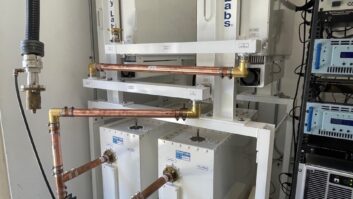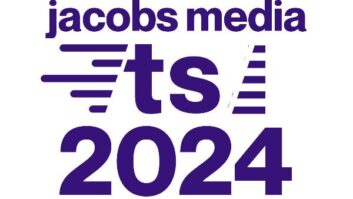When Philips and Sony introduced the compact disc in 1982, it marked the beginning of a transition for radio from analog vinyl to digital CDs as the primary playback medium.

The display screen for the CD jukebox showed the song playing, what was next and upcoming selections. The row of asterisks indicated amount of time left on the current song. Red and green lettering corresponded to colored pots on the board.
CDs had many advantages over vinyl, among them smaller size, better sound and more material per disc. But they also had disadvantages, several of which revolved around handling and storage.
Handling a CD with greasy or dirty hands could leave fingerprints on the disc, causing it to skip. Rough handling could scratch the CD’s surface, rendering it useless. Not returning a CD to its jewel case could cause it to get dusty, also resulting in erratic playback.
In 1985, Paul Shulins was chief engineer of WBOS, at the time a country-formatted station in Boston owned by Sconnix. Because there were no commercially-available products to address the CD handling issue, he decided to tackle the problem himself.
“At that time, all our music was on carts. I had been thinking about CD jukeboxes as a solution to the handling issue, and we purchased an Audio-Metrics CDX-1000 to experiment with,” said Shulins, who today is vice president and chief technology officer for Burk Technology.

Shulins’ original CD jukebox system, circa 1989, as used at WMJX. The same type of hardware was first used at WBOS in 1985.
Shulins wrote the code and used a Radio Shack color computer to control the CDX-1000 via its RS-232 port. The jukebox held 100 CDs and had just one play deck. That meant WBOS DJs had to alternate between songs on cart and the jukebox.
Designing a control interface that could be used by the WBOS DJs was a big part of the project. Bar codes were affixed to the side of the carts, which the talent would scan with a light pen which was connected to the PC via an RS-232 port.
In order to maintain control of the system through the barcode pen, Shulins created a laminated bar code menu, with items such as skip song, rescan and start over. CD selections were also scanned from barcodes on the music log. To keep the interface consistent, both cart decks and the jukebox were started through the console.
In some ways, the project was a proof-of-concept, and it worked quite well.
The next chapter of the CD jukebox evolution began when Shulins joined Greater Media Boston in 1988. He was chief engineer of WMJX and WBCS.

As the CD jukebox system was refined, Shulins got RCS Selector to print out the bar codes for each song right on the music log. The light pen was used to scan in an entire show’s worth of music in just a few seconds.
“I pitched the jukebox concept to Smitty [engineering executive Milford Smith], and after discussing the risks vs. benefits, he supported this new venture, and gave it his blessings. At that point, we purchased four CDX 1000s,” Shulins said.
By 1988, the early Radio Shack computers were slipping into obsolescence, and IBM PCs were everywhere. Shulins used one to control his next-generation jukebox system. The four jukeboxes were color-coded, two red and two green. Each jukebox held 100 CDs, with red and green being duplicates. That way it was always possible to segue from CD to CD. The red and green jukeboxes corresponded to red and green pots on the console, and red and green characters on the display screen.
The 1990s brought consolidation to the radio industry, and Greater Media’s Boston operation eventually grew to five stations.
“Hard drive storage of music was becoming more common,” Shulins said, “but we had concerns about audio quality with bitrate reduced storage, and the cost of storing linear audio for that many stations was too expensive. It was decided to revise and expand the jukebox system, and to use [Broadcast Electronics] AudioVault for storing and airing only commercials.”
The Audio-Metrics jukeboxes were replaced with NSM units, which were more compact, had better speed and were built to industrial standards. Shulins designed a TTL circuit to control them, since there was no RS-232 port available.

A special room was built at Greater Media’s Morrissey Blvd. facility in Boston to showcase the CD jukebox array. Custom furniture was made to house the players. The TV in the upper left showed what was playing on any of the five stations.
MORE ROOM REQUIRED
Each station now had four CD jukeboxes, a main red and green, and a backup red and green. With five stations, that amounted to 20 jukeboxes. That many can take up a lot of space, and questions arose as to where and how to house them.
“We decided to put the jukeboxes on display,” says Shulins. “We built a room with a large picture window in the hallway, and had custom furniture built to house them. A video monitor displayed the song currently playing on all five stations.”
The next step in the jukebox evolution happened when Shulins got RCS Selector to print out the music logs with the bar code next to the song. That meant there were no more bar code labels on the sides of carts, and all music entries were made with the light pen on the log sheet. Eventually, the system worked with text files, which were exported seamlessly from the music scheduling program. At that point, the bar codes were no longer necessary.

In the early days at WBOS in Boston, bar code labels were affixed to the side of carts to facilitate music entries into the computer playout system.
A sixth studio was built so that the control rooms for any of the five stations could be taken down for maintenance, or serve as an emergency backup. That raised the problem of how the new studio could access and control the jukebox system for any of the stations. Shulins designed and built a custom switching matrix which made that possible.
It wasn’t just the jukebox technology that was being revised. The way that the CDs were utilized as a storage medium also evolved over time.
“The CDs we received from record companies were not the most efficient way to store music. Most of them had one, or at the most, two hit songs,” Shulins said. “The rest of the tracks were not on the station’s playlist, and this amounted to a great deal of wasted space. To make the storage more efficient, we subscribed to Hit Discs, which was a service from TM Century 21 in Dallas. They sent out CDs with 18–19 hit songs, most of which were on our playlist.”

Eventually, NSM jukeboxes replaced the older Audio-Metrics units. They were smaller, faster and more reliable. NSMs were used at Greater Media for more than a decade to serve five radio stations in an array of 20 units, four for each station.
CD-Recordable technology evolved quickly during the ’90s, and Shulins soon built a dubbing station in a roll-around rack. It had a portable mixer, CD deck and CD-R recorder. By recording their own CDs for the jukeboxes, the Greater Media stations ensured that virtually 100 percent of a CD’s content was on the playlist.
The system performed well but was not without its problems, Shulins recalls. “On rare occasions, a CD in a jukebox wouldn’t cue, usually due to a bad copy. It would try for 30 seconds before giving up. During that time, the DJs could do nothing, which was very frustrating.”
Overall though, the final evolution of Shulins’ jukebox system performed very well, and it remained in service for nearly two decades.
Ultimately, it went beyond an engineering achievement. The “Magic CD Jukebox” was also referenced on air daily in promos, helping to brand the radio station, and the light pen beep heard as the music was being loaded was part of the imaging.
Share your memories of gear that made up daily life in radio. Email [email protected].
Tom Vernon wrote about the Hallicrafters SX-42 in the Dec. 6 issue.











